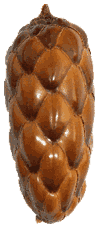 |
Palm |
 |
Palm |
Coccothrinax borhidiana is confined to a small coastal area named Punta Guanos, west of Matanzas Bay, along the northern coast of Cuba, part of the Caribbean Hotspot. It is restricted to coastal dry scrub vegetation on limestone terraces in a strip of about 8 ha along the coast. The actual population comprises 252 adult palms.
Coccothrinax borhidiana is a fan palm growing 2–4 m tall. The trunk, 7 or 8 cm of diameter, bears a dense “skirt” of dead (marcescent) leaves, which gives this palm very distinctive appearance unlike other Coccothrinax species. The leaves are orbicular, rigid, grayish-green on both sides, with 19–22 segments, with petioles ending in a fibrous sheath that has the appearance of a coarsely woven fabric. The inflorescence is ascending and compact. The tiny, yellowish-white flowers are bisexual. The fruits are 0.5–0.7 cm in diameter, almost round, and purple-black at maturity.
This peculiar palm was discovered in 1970 by the late Cuban botanist O. Muñíz, who named the new species after Atila Borhidi, a well-known Hungarian botanist who has conducted extensive research on the Cuban flora and vegetation. Nothing is known nor documented about any human use of this palm, as its native locality was well hidden and the locality poorly known. Neither the pollination biology of C. borhidiana nor its dispersal agents have been studied. Flowering occurs mainly in the summer wet season. Germination takes place in 2 or 3 months after fruit collection, and ex situ germination studies report a germination rate of 32–44%. The seeds are often parasitized by a beetle (Coccotrypes dactyliperda: Scolytidae) that can damage up to 50% of the seed crop.
| Coccothrinax borhidiana in the ex situ collection of the Jardín Botánico Nacional, Habana, Cuba. |
Fire, road construction and nearby oil extraction are the greatest threats to survival of Coccothrinax borhidiana. The very small population size adds to the level of threat to this palm, which is found nowhere else along the northern coast west of Matanzas Bay, even in the same ecosystem.
Although the place, Punta Guanos, has had official conservation status in the province since 1984. The Matanzas Botanic Garden staff is taking effective actions for conserving both the natural population and ex situ cultivation of this remarkable species. On behalf of C. borhidiana, the Matanzas Botanic Garden is providing information on the importance and risks for the species, as well as environmental education of children and youth in schools.
The conservation strategy of Coccothrinax borhidiana could also include the possible introduction of it into a similar ecosystems in northwest coast of Matanzas. It would need the production of plants through massive collection and germination of seed from the natural population.
The ex situ collection at Jardín Botánico Nacional (Habana, Cuba) includes three seed-producing palms and could also be used for germplasm production.
Dr. Angela Leiva Sánchez, Jardín Botánico Nacional, Cuba
Borhidi A., N. Imchanitzkaja, & O. Muñiz. 1978.
Dendrological novelties in the flora of Cuba.
Acta Agronom. Acad. Sci. Hung. 27: 437.
Borhidi, A. 1991.
Phytogeography and Vegetation Ecology of Cuba.
Akademiai. Kiadó Budapest.
Castillo, E., E. Sordo, R. Batista & R. López (unpublished).
Coccothrinax borhidiana Muñiz.
Características del fruto, semilla y crecimiento de plantas en vivero.
Enríquez A., L. Robledo & R. Cruz. (in press)
Notas sobre la distribución y conservación de Coccothrinax borhidiana en Cuba.
Revista Jard. Bot. Nac. Univ. Habana